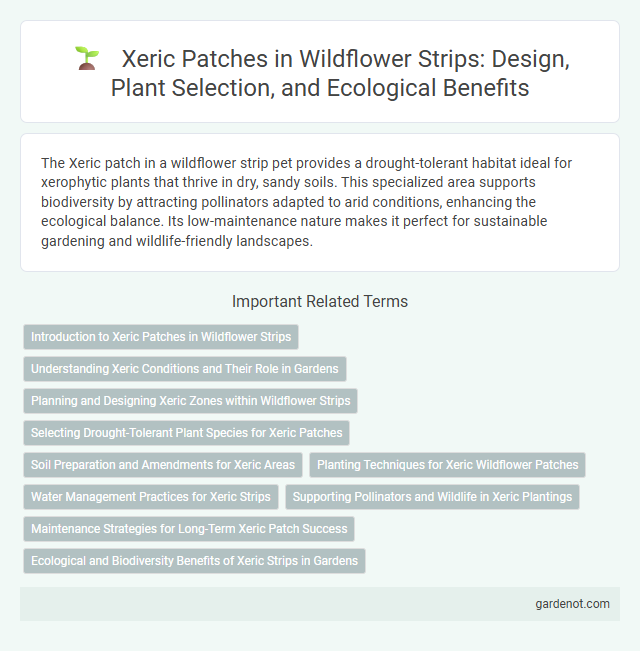The Xeric patch in a wildflower strip pet provides a drought-tolerant habitat ideal for xerophytic plants that thrive in dry, sandy soils. This specialized area supports biodiversity by attracting pollinators adapted to arid conditions, enhancing the ecological balance. Its low-maintenance nature makes it perfect for sustainable gardening and wildlife-friendly landscapes.
Introduction to Xeric Patches in Wildflower Strips
Xeric patches in wildflower strips are specialized zones designed to support drought-tolerant plant species that thrive in dry, well-drained soil conditions. These patches enhance biodiversity by providing habitat for pollinators such as native bees and butterflies that rely on xeric flora for nectar and shelter. Incorporating xeric patches into wildflower strips promotes ecological resilience and water conservation in landscape management.
Understanding Xeric Conditions and Their Role in Gardens
Xeric patches are designed to thrive in dry, low-moisture conditions by utilizing drought-tolerant plants adapted to such environments. These areas promote water conservation while supporting native flora and pollinators that flourish in arid habitats. Incorporating xeric patches in wildflower strips enhances garden sustainability and biodiversity by reducing irrigation needs and providing specialized ecological niches.
Planning and Designing Xeric Zones within Wildflower Strips
Planning and designing xeric zones within wildflower strips involves selecting native drought-tolerant plants that thrive in low-water conditions to create sustainable habitats. Incorporating soil amendments and carefully assessing sun exposure ensures optimal growth and water conservation. Strategically placing xeric patches enhances biodiversity and supports pollinators while reducing irrigation needs.
Selecting Drought-Tolerant Plant Species for Xeric Patches
Selecting drought-tolerant plant species for xeric patches ensures sustainable wildflower strips that thrive with minimal water input. Native plants such as purple coneflower, black-eyed Susan, and prairie dropseed adapt well to arid conditions and promote biodiversity. These species enhance soil health and provide habitat for pollinators, maintaining ecosystem balance in xeric environments.
Soil Preparation and Amendments for Xeric Areas
Soil preparation for a xeric patch involves ensuring excellent drainage by incorporating coarse sand or gravel to prevent water retention. Amending the soil with organic matter such as compost enhances nutrient availability while maintaining a balance that supports drought-tolerant wildflowers. Avoid heavy clay soils and aim for a well-aerated, sandy or rocky substrate that mimics natural arid conditions.
Planting Techniques for Xeric Wildflower Patches
Planting techniques for xeric wildflower patches emphasize soil preparation with well-draining substrates to mimic natural arid conditions. Incorporating native drought-tolerant species like Echinacea, Gaillardia, and Penstemon ensures sustainable growth and minimal irrigation. Strategic seed dispersal and mulching with gravel or sand improve moisture retention while preventing weed competition in these dry environments.
Water Management Practices for Xeric Strips
Xeric patches in wildflower strips utilize water management practices such as mulching with organic materials to retain soil moisture and reduce irrigation needs. Incorporating drought-resistant native plants with deep root systems enhances water absorption and promotes sustainable hydration. Strategic soil amendments improve drainage and prevent waterlogging, optimizing water use efficiency in xeric wildflower strips.
Supporting Pollinators and Wildlife in Xeric Plantings
Xeric patches in wildflower strips provide essential habitat and food sources for pollinators like bees, butterflies, and hummingbirds by utilizing drought-tolerant native plants such as Echinacea, Gaillardia, and Asclepias. These native xeric plants produce nectar-rich flowers and support a wide range of insect species critical for pollination and ecosystem health. Incorporating diverse xeric species enhances biodiversity, promotes resilience to climate variability, and sustains local wildlife populations in water-efficient landscapes.
Maintenance Strategies for Long-Term Xeric Patch Success
Effective maintenance strategies for xeric patches prioritize minimal irrigation and careful soil monitoring to sustain drought-tolerant wildflowers. Employing periodic pruning and mulching controls weed growth and conserves moisture, enhancing plant resilience. Regular assessment of native species health and adaptive management ensures long-term ecological balance and aesthetic appeal in xeric environments.
Ecological and Biodiversity Benefits of Xeric Strips in Gardens
Xeric patches in wildflower strips promote ecological balance by providing habitat for drought-tolerant native plants and pollinators, enhancing local biodiversity. These areas conserve water by supporting species adapted to arid conditions, reducing irrigation needs in garden ecosystems. Xeric strips also improve soil health and create microhabitats that sustain beneficial insects and small wildlife, contributing to resilient urban green spaces.
Xeric patch Infographic

 gardenot.com
gardenot.com